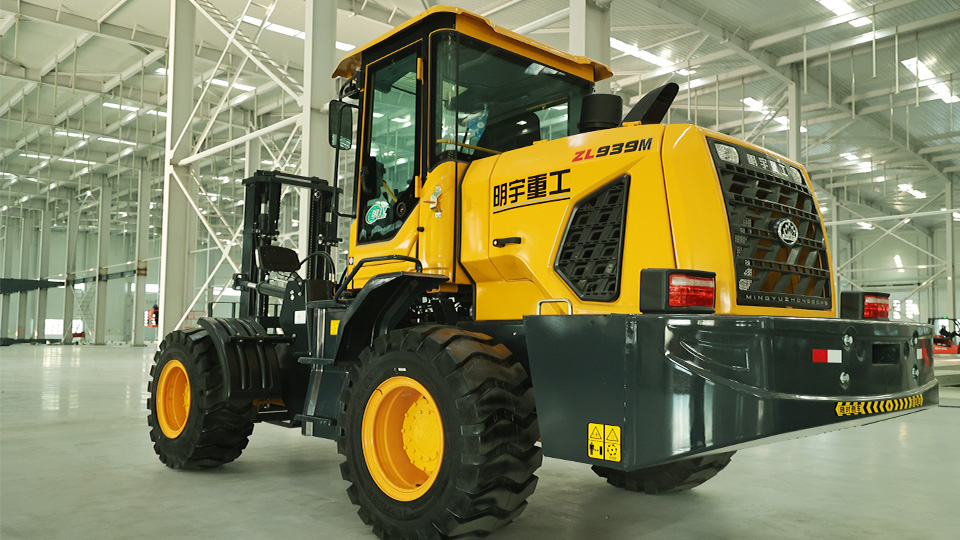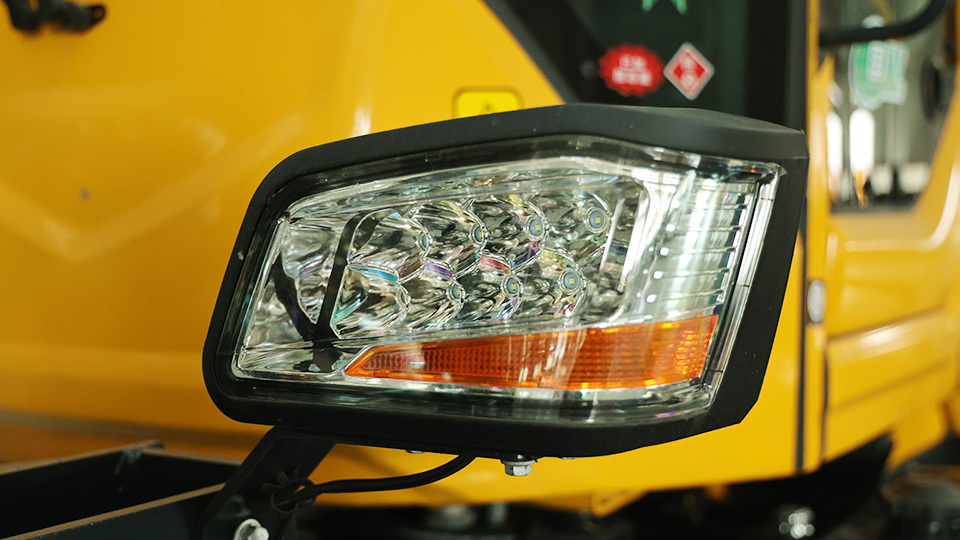
Introduction
Hook: Start with the inherent risks of operating heavy machinery, especially rough terrain forklifts (RTFLs), in dynamic and uneven environments.
Problem Statement: Emphasize that tip-overs are among the most serious and common hazards associated with RTFL operation, leading to severe injuries or fatalities.
Thesis Statement: This article will provide a comprehensive technical guide for RTFL operators, detailing the principles of stability, the contributing factors to tip-overs, and the critical operational techniques and safety protocols necessary to prevent these dangerous incidents.
I. Understanding Rough Terrain Forklift Stability A. The Stability Triangle/Pyramid:
Concept: Explain this fundamental principle for forklifts. Illustrate with diagrams (mental imagery or actual if possible).
Pivot Point: Identify the pivot points (front axle or steer axle midpoint).
Center of Gravity (CG):
Forklift's CG: Explain how it shifts with mast extension, load height, and inclination.
Load's CG: Importance of knowing the load's center.
Combined CG: The critical point that must stay within the stability triangle.
Dynamic vs. Static Stability: Differentiate between stability when stationary (static) and when moving, lifting, or on uneven ground (dynamic). Emphasize dynamic stability as the primary concern for RTFLs.
B. Factors Affecting Stability:
Weight Distribution: How distributed weight impacts stability.
Moment: Force x distance. Explain how the load's weight creates a forward tipping moment, countered by the forklift's rearward moment.

Leverage: How increasing load height or extending the boom increases leverage against stability.
Ground Contact: Importance of all wheels maintaining contact; loss of contact reduces the base of stability.
II. Primary Causes of Rough Terrain Forklift Tip-Overs
A. Driving on Uneven or Sloped Surfaces:
Lateral Tip-Overs: Explain how driving across a slope or hitting a bump/hole on one side dramatically shifts the combined CG outside the lateral stability line.
Longitudinal Tip-Overs (Forward/Rearward): Driving up/down slopes with load positioned incorrectly.
Soft Ground/Undermining: How sinking into mud or soft shoulders can cause sudden shifts in stability.
B. Overloading or Incorrect Load Handling:
Exceeding Rated Capacity: Gross overloading is a direct path to tip-over. Explain the concept of load charts.
Exceeding Load Center: Load extending too far from the mast/carriage, increasing the leverage.
Unstable or Shifting Loads: Loads that are not properly secured or that can shift during transport/lifting.
Jerking or Sudden Movements: Rapid acceleration, braking, or turning with a raised or heavy load.
C. Speed and Maneuvering Errors:
Excessive Speed: Particularly on turns or uneven ground, leading to centrifugal forces that overcome stability.
Sharp Turns: Especially with a raised load.
Driving with Load Raised High: Significantly reduces the base of stability, especially when moving.
D. Attachment Misuse:
Improper Attachment Selection: Using an attachment not rated for the forklift or task.
Incorrect Attachment Installation: Not properly secured.
Impact on Capacity: Attachments add weight and change the load center, often requiring de-rating the forklift's capacity.
E. Lack of Operator Awareness and Training:
Unfamiliarity with Equipment: Not understanding the specific RTFL's capabilities and limitations.
Ignoring Site Conditions: Failing to assess terrain, weather, and potential hazards.
Complacency: Overconfidence leading to unsafe practices.
III. Pre-Operational Checks and Site Assessment
A. Pre-Shift Inspection (Daily Checks):
Tires: Condition, inflation (critical for stability and traction).
Fluid Levels: Fuel, oil, hydraulics.

Controls: Functionality of steering, brakes, lift, tilt.
Safety Devices: Lights, horn, backup alarm, seatbelt, ROPS/FOPS integrity.
Hydraulic Leaks: Indications of potential system failures.
Load Chart/Data Plate: Ensure it's legible and understood.
B. Site Assessment:
Ground Conditions: Identify soft spots, mud, water, ice, snow, loose gravel, holes, debris, ruts, obstacles.
Slopes and Grades: Determine maximum safe operating angles.
Overhead Obstructions: Power lines, tree branches, building structures.
Pedestrian Traffic: Clear communication and designated safe zones.
Weather Conditions: Wind (major factor for high lifts), rain, visibility.
Load Path Planning: Visualizing the path to avoid hazards and ensure stable travel.
IV. Safe Operating Procedures to Prevent Tip-Overs
A. Load Handling Best Practices:
Consult the Load Chart: Always adhere to the rated capacity and load center. Understand de-rating for attachments.
Secure the Load: Ensure the load is stable and centered on the forks. Use dunnage or restraints if necessary.
Carry Load Low and Tilted Back: The safest position for travel, maximizing stability. Explain why.
Do Not Jerk or Drop Loads: Smooth, controlled movements are essential.
Avoid Overloading: Never attempt to lift a load beyond the forklift's rated capacity.
B. Driving on Slopes and Uneven Terrain:
Load Uphill, Forks Downhill:
Loaded: Always travel with the load pointing uphill when going up or down a slope. Explain why this maintains stability (keeps combined CG further inside the stability triangle).
Unloaded: Travel with forks pointing downhill when going up or down a slope.
Straight Up/Down Slopes: Avoid driving diagonally across slopes; this drastically reduces lateral stability.
Maintain Safe Speed: Adjust speed to ground conditions. Slower is always safer.
Avoid Sudden Movements: No sudden turns, braking, or acceleration.
Negotiate Obstacles Carefully: Approach bumps or ruts squarely and slowly.
Beware of Soft Ground: Test ground if unsure; avoid operating near ditches or embankments.
C. Maneuvering and Speed Control:
Slow Down for Turns: Especially with a load. Centrifugal force can cause a lateral tip-over.
No Sudden Stops or Starts: Smooth operation.
Lower Load Before Turning: If the load must be raised, lower it before making any turns.
Maintain Clear Line of Sight: Use spotters if visibility is restricted.
D. Using Outriggers/Stabilizers (Telehandlers):
When to Deploy: Always deploy outriggers/stabilizers when lifting heavy loads, extending the boom significantly, or operating on uneven ground.
Full Extension and Firm Ground: Ensure outriggers are fully extended and placed on solid, level ground (use cribbing if necessary).
Leveling: Use the leveling system to ensure the machine is absolutely level before making a lift.
E. General Safety Practices:
Wear Seatbelt: Crucial for containing the operator within the ROPS/FOPS in case of a tip-over.
Avoid Horseplay: Forklifts are not toys.
Never Carry Passengers: Unless the machine is specifically designed with a passenger seat.
No Stunt Driving: Reckless operation is a primary cause of accidents.
V. What to Do in Case of a Tip-Over Stay with the Machine: The primary directive. The ROPS/FOPS provides a zone of protection. Do not jump!
Brace for Impact: Grip the steering wheel firmly.
Lean Away from the Point of Impact: Lean in the opposite direction of the tip.
Do NOT Jump: Explain why jumping is more dangerous (risk of being crushed by the falling machine or mast).
Emergency Response: Shut down the machine, assess injuries, call for help.
Incident Reporting: Full investigation of the cause.
Conclusion
Recap: Reiterate that preventing RTFL tip-overs is a combination of understanding stability, thorough pre-operational checks, diligent site assessment, and strict adherence to safe operating procedures.
Reinforce: The operator's direct responsibility and the importance of continuous training and vigilance.
Final Thought: Emphasize that safety is paramount, and a methodical, disciplined approach to RTFL operation is the best defense against dangerous tip-over incidents.
Key Technical Details to Elaborate On:
Load Center Calculation: Explain the concept of the load center (distance from the vertical face of the forks to the center of gravity of the load).
Load Chart Interpretation: Provide a detailed explanation of how to read and interpret a rough terrain forklift's load chart, emphasizing that capacity changes dramatically with height, reach, and attachment. Include examples of de-rated capacities.
Axle Oscillation/Articulation: How these features, unique to RTFLs, contribute to maintaining ground contact and stability on uneven surfaces.
Traction Control Systems: Briefly discuss any advanced traction control features that might assist operators.
Hydrostatic vs. Torque Converter Drivetrains: How the characteristics of each transmission type (e.g., precise creep control of hydrostatic) can impact safe operation on slopes and uneven ground.
ROPS/FOPS Standards: Briefly mention the relevant ANSI/ISO standards for these protective structures.
Importance of Level Indicators: How they guide the operator in ensuring the machine is level before making a lift, especially for telehandlers.
Name: selena
Mobile:+86-13176910558
Tel:+86-0535-2090977
Whatsapp:8613181602336
Email:vip@mingyuforklift.com
Add:Xiaqiu Town, Laizhou, Yantai City, Shandong Province, China